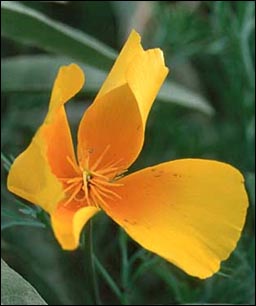
April 6 is California Poppy Day, in special tribute to our state flower. Four California Poppy varieties are found in California. It can be found in areas ranging from grassy and disturbed areas west of the Sierras in valleys, foothills and along the coast. The perennial coastal variety is the most commonly commercially available seed type, and should be the type planted in gardens in its natural area.
Poppies have showy flowers and fine gray-green leaves. The flowers unfurl from a pointed cap, after which the petals open in sunshine, and close in the evening or cooler weather. Sometimes bees rest in the closed petals overnight. On seeding, the capsules are also long and pointed, and twist on drying to pop and scatter the seeds. In warmer areas, they grow as several-year perennials; in colder areas, they perform best as annuals.
On More Mesa, Poppies have been seen flowering as early in December, depending upon rainfall, and can continue flowering through spring and summer. In the garden, they are best sown in open areas where they can grow largely unattended. Seeds should be planted in the fall in well-drained soil, where they can be kept moist for germination, which takes about a week.
The California Poppy, Eschscholzia californica, was named after Johann Friedrich Eschscholtz. It was used by Caifornia Indians as a source of food and oil.
The poppies above were photographed on Figueroa mountain, and the picures below were taken December 2002 and April 2003 on More Mesa.
Resources:
An interesting article about the coastal variety (grows along the cliffs of More Mesa) of California Poppy, written by Wayne Chapman of CCBER.
 |
 |